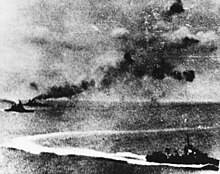Renown class
 HMS Repulse in 1916 HMS Renown after renovations in 1939  |
|
|
|
|
|---|---|
| Displacement: | 26,500 ts standard / 30,100 ts maximum |
| Length: | 240 m |
| Width: | 30 m |
| Draft: | 8.94 m |
| Drive: | 4 Brown Curtis steam turbines , 42 boilers, 120,000 shp |
| Speed: | 32 kn (approx. 59 km / h) |
| Crew: | 953 |
| Armament: | Guns:
Torpedo tubes:
|
Under the name Renown class which provided the Royal Navy during the First World War two battle cruisers in service.
Development and construction
The two ships of the class, HMS Renown and HMS Repulse , were originally before the war as battleships of the Revenge class were appointed. However, the original orders were canceled at the end of 1914 because the construction time could not be guaranteed. With the return of Lord John Fisher to the post of First Sea Lord , however, the construction contracts were reassigned, with Fisher relying on battle cruisers. The design submitted by Eustace Tennyson-D'Eyncourt should be able to save money and construction time and achieve higher speeds by reducing the main turrets from four to three and lighter armor.
Construction of the two ships began in early 1915 with the keel-laying, after the HMS Resistance had previously been canceled and the number of planned ships had been reduced from three to two. The ships were launched at the beginning of 1916 and commissioned towards the end of the year. At that time, the ships were for a short time the largest combat units in the world, this record was broken in 1918 by the HMS Hood .
history
The two ships began their regular fleet service in the First World War, but came too late for the Battle of the Skagerrak . The first combat deployment of the two ships took place in 1917 in the sea battle near Helgoland . In contrast to the ships of the Revenge class, however, the Renown and the Repulse were extensively modernized in the interwar period and, above all, the type ship was equipped with new armor, fire control devices , catapults for seaplanes and additional anti- aircraft guns . Due to these capabilities and the high speed, the ships were therefore used on the front line in World War II , even if they earned the nicknames "HMS Repair" and "HMS Refit" due to their long stays in the shipyard.
The Renown was involved in the search for the Admiral Graf Spee in 1939 . During the company's Weserübung could both modern but armed only with 28-cm guns German battleships on 9 April 1940 Gneisenau and Scharnhorst force for twisting off. She later belonged to Force H in Gibraltar and operated in the Mediterranean and Atlantic , where she took part in the 1941 hunt for the Bismarck . She then served in the Home Fleet and was later stationed on Ceylon . She was the only British battle cruiser to survive the war and was scrapped in 1948 after a brief deployment as a training ship.
The Repulse initially carried out similar missions as the Renown during the war . After moving to Singapore in the autumn of 1941, she was sunk by Japanese naval planes on December 10th of that year together with the Prince of Wales .
See also
Web links
- Sheet and shipping information (English)
- Details on the construction of (English)
- History and images of HMS Renown (English)
- History and pictures of the HMS Repulse (English)

